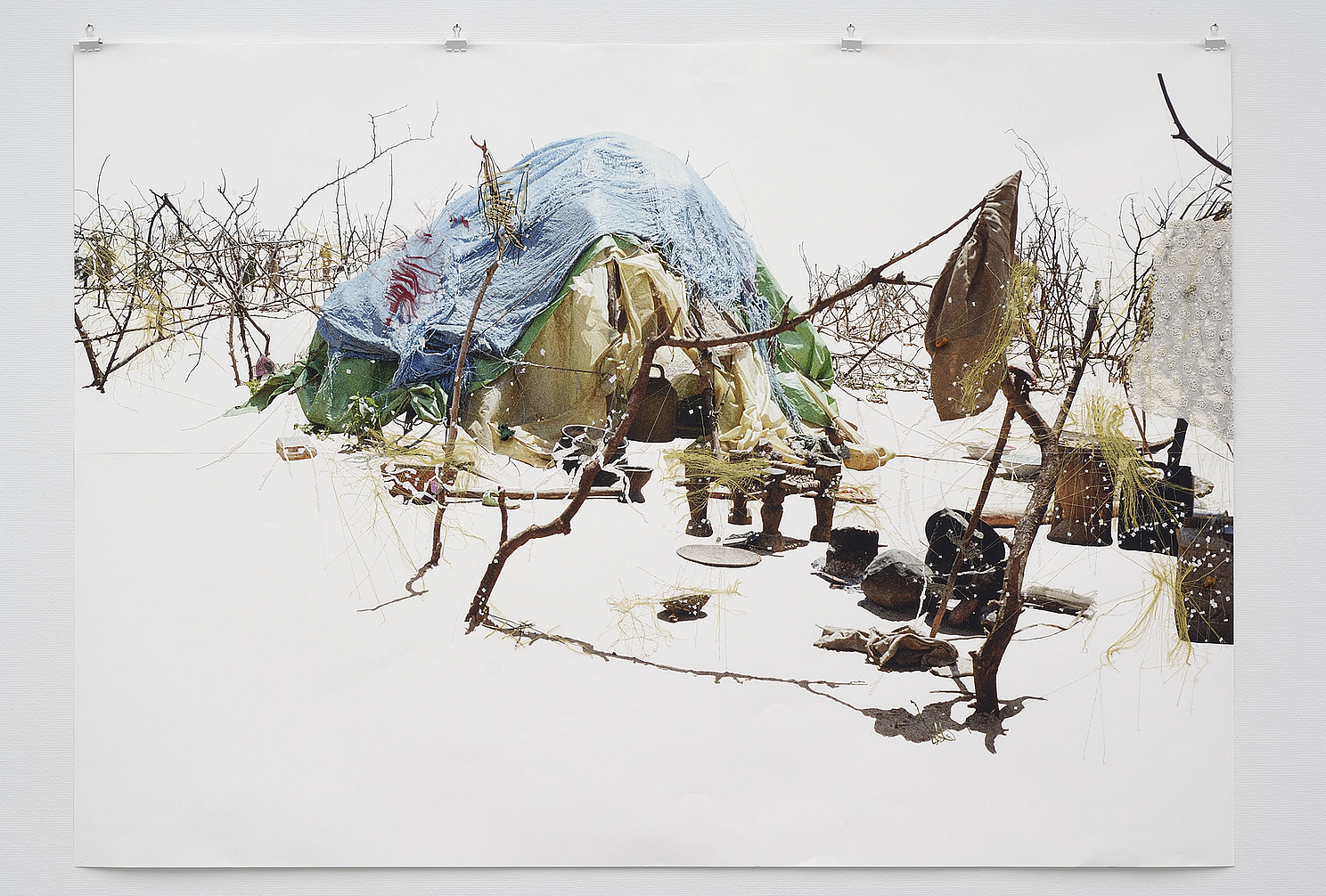Christiaan Bastiaans
Year Zero
8 Sept - 28 Oct 2007
In the project space, Christiaan Bastiaans (1951) has produced an installation involving a number of large photographic works, textile sculptures, drawings and collages from the years 1999 to 2007. While the space has been furnished in a subdued and austere manner, the works themselves are charged with associative meaning.
Bastiaans describes his themes as an investigation of the human condition. In order to fathom the essence of human existence, he seeks situations that revolve around life and death, beauty and horror, and he travels to places where man must rely on the most basic survival strategies. Over the past years he has been to such countries as Uganda, Sierra Leone, Chad and Sudan. Notes and drawings made in these places constitute the basis for works of art. In addition to this, Bastiaans takes photographs. But the photographs that he brings back from these war-torn regions have little to do with the flood of images broadcast in the media every day. Bastiaans wants to give greater validity to the momentary and specific nature of what he sees and experiences.
In the large photographic works, every superfluous aspect has been filtered away, and the photographed reality is reduced to its essence. Only once in this exhibition do we stand eye to eye with an individual – a member of a militia; the other photographic works involve the type of human being who seeks protection in a makeshift shelter or simply shrouded in a carpet. Often all sorts of materials and objects have been applied to the photographs. Pulp, silk and a web of threads provide, no matter how delicate and fragile, a second protective layer, just as the minerals and medicinal plants incorporated in several works seem to have a curative effect. This theme of a protective covering can also be seen in the sculpture. The three-dimensional textile forms are a cross between clothing and live creatures. These are ‘hurt’ models, whose identity is derived from the various materials of which they consist: tulle, cotton wool, gauze, newspaper. In a transparent piece of clothing, the form of a Kalashnikov can be discerned; a mutilated arm, made heavier by an iron weight, is inscribed with excerpts from Shakespeare’s King Lear. Whereas the ‘hurt’ models have an aura of motionless silence, the drawings and assemblages give rise to an unstoppable flow of meanings and associations. In the assemblages, photographs and prints develop into drawn depictions; current events are mixed with those from World War I or with images from a psychiatric institution, and the reality seen becomes a myth. Bastiaan’s visual world offers us a glimpse of the plague, the symbol of the evil that creeps into society and possibly into the very pores of our being. At the same time, these works on paper attest to a great vulnerability and are, in themselves, the embodiment of fragility. Due to the materials used, they are literally frail and brittle; but more significantly, Bastiaans has employed this fragility as a visual quality, as a method by which to give shape to a charged theme within the context of art.
In the large photographic works, every superfluous aspect has been filtered away, and the photographed reality is reduced to its essence. Only once in this exhibition do we stand eye to eye with an individual – a member of a militia; the other photographic works involve the type of human being who seeks protection in a makeshift shelter or simply shrouded in a carpet. Often all sorts of materials and objects have been applied to the photographs. Pulp, silk and a web of threads provide, no matter how delicate and fragile, a second protective layer, just as the minerals and medicinal plants incorporated in several works seem to have a curative effect. This theme of a protective covering can also be seen in the sculpture. The three-dimensional textile forms are a cross between clothing and live creatures. These are ‘hurt’ models, whose identity is derived from the various materials of which they consist: tulle, cotton wool, gauze, newspaper. In a transparent piece of clothing, the form of a Kalashnikov can be discerned; a mutilated arm, made heavier by an iron weight, is inscribed with excerpts from Shakespeare’s King Lear. Whereas the ‘hurt’ models have an aura of motionless silence, the drawings and assemblages give rise to an unstoppable flow of meanings and associations. In the assemblages, photographs and prints develop into drawn depictions; current events are mixed with those from World War I or with images from a psychiatric institution, and the reality seen becomes a myth. Bastiaan’s visual world offers us a glimpse of the plague, the symbol of the evil that creeps into society and possibly into the very pores of our being. At the same time, these works on paper attest to a great vulnerability and are, in themselves, the embodiment of fragility. Due to the materials used, they are literally frail and brittle; but more significantly, Bastiaans has employed this fragility as a visual quality, as a method by which to give shape to a charged theme within the context of art.
